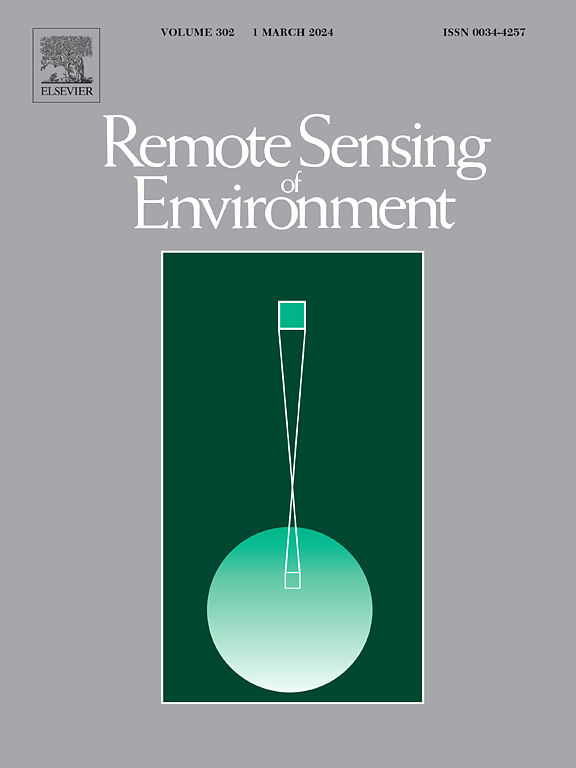Comparing satellite and BGC-Argo chlorophyll estimation: A phenological study
IF 11.1
1区 地球科学
Q1 ENVIRONMENTAL SCIENCES
引用次数: 0
Abstract
Ocean primary production is a key process that regulates marine ecosystems and the global climate, but its estimation is still affected by multiple uncertainties. Typically, the chlorophyll-a concentration (CHL) is used to characterise this process, as it is considered as a proxy of phytoplankton biomass. To date, the most common observing systems for studying CHL are ocean colour satellites and Biogeochemical-Argo (BGC-Argo) floats. These are complementary systems: satellite observations provide global coverage but are limited to the ocean surface, while BGC-Argo floats provide punctual observations along the whole water column. Quantitative matching of these two observing systems has been obtained only at regional or single-float scales, while at a global scale the relatively low and irregular BGC-Argo coverage results in large uncertainties. Here, we propose a different method, by comparing satellite and BGC-Argo climatological annual time series within seven different bioregions, each characterised by a homogeneous phytoplankton phenology, allowing us to smooth the uncertainties. By comparing the mean values, amplitudes, and shapes of the two time series, we identify regions (a) where they agree (58%–61% of the ocean surface area); (b) regions undersampled by the BGC-Argo float network (particularly in the Arabian Sea and near the Amazon delta); (c) where the discrepancy may stem from satellite or (d) BGC-Argo performance (mainly found at subtropical and high latitudes, respectively). Caution is required when using BGC-Argo and satellite data in regions b–d, and, for each region, we provide suggestions on which system could be affected by the largest uncertainties.
比较卫星和BGC-Argo叶绿素估算:物候研究
海洋初级生产是调节海洋生态系统和全球气候的关键过程,但其估算仍受到多种不确定因素的影响。通常,叶绿素-a浓度(CHL)被用来表征这一过程,因为它被认为是浮游植物生物量的一个代表。迄今为止,研究CHL最常用的观测系统是海洋彩色卫星和生物地球化学- argo (BGC-Argo)浮标。这些是互补的系统:卫星观测提供全球覆盖,但仅限于海洋表面,而BGC-Argo浮标提供沿整个水柱的准时观测。这两个观测系统的定量匹配仅在区域或单浮标尺度上得到,而在全球尺度上,BGC-Argo覆盖相对较低且不规则,导致了很大的不确定性。在这里,我们提出了一种不同的方法,通过比较七个不同生物区的卫星和BGC-Argo气候年时间序列,每个生物区的特征都是均匀的浮游植物物候,使我们能够消除不确定性。通过比较两个时间序列的平均值、振幅和形状,我们确定了(a)它们一致的区域(58%-61%的海洋表面积);(b) BGC-Argo浮子网取样不足的区域(特别是在阿拉伯海和亚马逊三角洲附近);(c)差异可能来自卫星或(d) BGC-Argo表现(分别主要出现在副热带和高纬度地区)。在b-d区域使用BGC-Argo和卫星数据时需要谨慎,对于每个区域,我们提供了哪些系统可能受到最大不确定性影响的建议。
本文章由计算机程序翻译,如有差异,请以英文原文为准。
求助全文
约1分钟内获得全文
求助全文
来源期刊

Remote Sensing of Environment
环境科学-成像科学与照相技术
CiteScore
25.10
自引率
8.90%
发文量
455
审稿时长
53 days
期刊介绍:
Remote Sensing of Environment (RSE) serves the Earth observation community by disseminating results on the theory, science, applications, and technology that contribute to advancing the field of remote sensing. With a thoroughly interdisciplinary approach, RSE encompasses terrestrial, oceanic, and atmospheric sensing.
The journal emphasizes biophysical and quantitative approaches to remote sensing at local to global scales, covering a diverse range of applications and techniques.
RSE serves as a vital platform for the exchange of knowledge and advancements in the dynamic field of remote sensing.
 求助内容:
求助内容: 应助结果提醒方式:
应助结果提醒方式:


